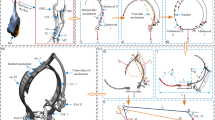Abstract
Underwater robotic vehicles (URVs) have become an important tool for numerous underwater tasks due to their greater speed, endurance, depth capability, and a higher factor of safety than human divers. However, most vehicle control system designs are based on simplified vehicle models and often result in poor vehicle performance due to the nonlinear and time-varying vehicle dynamics having parameter uncertainties. Conventional proportional-integral-derivative (PID) type controllers cannot provide good performance without fine-tuning the controller gains and may fail for sudden changes in the vehicle dynamics and its environment. Conventional adaptive control systems based on parameter adaptation techniques also fail in the presence of unmodeled dynamics.
This paper describes a new vehicle control system using the bound estimation techniques, capable of learning, and adapting to changes in the vehicle dynamics and parameters. The control system was extensively “wet-tested” on the Omni-Directional Intelligent Navigator (ODIN)-a six degree-of-freedom, experimental underwater vehicle developed at the Autonomous Systems Laboratory, and its performance was compared with the performance of a conventional linear control system. The results showed the controller's ability to provide good performance in the presence of unpredictable changes in the vehicle dynamics and its environment, and it's capabilities of learning and adapting.
Similar content being viewed by others
References
Adam, J.A. 1985. Probing beneath the sea. IEEE Spectrum, pp. 55–64.
Astrom, K.J. and Wittenmark, B. 1989. Adaptive Control, Addison Wesley.
Bellingham, J.G. and Chryssostomidis, C. 1993. Economic ocean survey capability with AUVs. Sea Technology, pp. 12–18.
Blidberg, D.R. 1991. Autonomous underwater vehicles: A tool for the ocean, unmanned systems. Spring, pp. 10–15.
Britton, P. 1995. Undersea explorers. Popular Science, pp. 39–42.
Brock, D.L., Montana, D.J., and Ceranowicz, A.Z. 1992. Coordination and control of multiple autonomous vehicles. Proc. 1992 IEEE Conf. Robotics and Automation, pp. 2725–2730.
Choi, S.K., Yuh, J., and Keevil, N. 1993. Design of omni-directional underwater robotic vehicle. Proc. IEEE Oceans. 1993.
Choi, S.K., Yuh, J., and Takashige, G. 1995. Development of the omni-directional intelligent navigator. IEEE Robotics and Automation Magazine, pp. 44–53.
Cristi, R., Papoulias, F.A., and Healey, A.J. 1991. Adaptive sliding mode control of autonomous underwater vehicles in the dive plane. IEEE J. of Oceanic Engineering, 15(3):462–470.
Dane, A. 1993. Robots of the deep. Popular Mechanics, pp. 104–105.
Dougherty, F. and Woolweaver, G. 1990. At sea testing of an under-water vehicle flight control system. Proc. AUV'90, pp. 51–59.
Fossen, T.I. 1991. Nonlinear Modeling and Control of Underwater Vehicles. Dr. Ing Thesis, NIT.
Fossen, T.I. 1995. Underwater vehicle dynamics. Underwater Robotic Vehicles: Design and Control, Yuh (ed.), pp. 15–40.
Goheen, K.R. and Jefferys, E.R. 1990. Multivariable self-tuning autopilots for autonomous and remotely operated underwater vehicles. IEEE J. of Oceanic Engr., 15(3):144–151.
Healey, A.J. and Marco, D.B. 1992. Slow speed flight control of autonomous underwater vehicles: Experimental results with NPS AUV II. Proc. ISOPE, pp. 523–532.
Kato, N., Ito, Y., Kojima, J., Asakawa, K., and Shirasaki, Y. 1993. Guidance and control of autonomous underwater vehicle AQUA explorer 1000 for inspection of underwater cables. Proc. 8th Int'l. Sym. on Unmanned, Untethered Submersible Technology.
Lewis, D.J., Lipscomb, J.M., and Thompson, P.G. 1984. The simulation of remotely operated underwater vehicles. ROV'84, pp. 245–252.
Mahesh, H., Yuh, J., and Lakshmi, R. 1991. A coordinated control of an underwater vehicle and robotic manipulator. J. of Robotic Systems, 8(3):339–370.
Nomoto, M. and Hattori, M. 1986. A deep ROV, dolphin 3K: Design and performance analysis. IEEE Journal of Oceanic Engineering, V/OE-11(3):373–391.
Sagatun, S.I. 1992. Modeling and control of underwater vehicles: Lagrangian approach. Dr. Ing. Thesis, Norwegian Institute of Technology.
Tucker, J.B. 1986. Submersibles reach new depths. High Technology, pp. 17–24.
Yoerger, D.N. and Slotine, J.E. 1985. Robust trajectory control of underwater vehicles. IEEE J. of Oceanic Engineering, OE-10(4):462–470.
Yuh, J. 1990a. A neural net controller for underwater robotic vehicles. IEEE J. Oceanic Engineering, 15(3):161–166.
Yuh, J. 1990b. Modeling and control of underwater robotic vehicles. IEEE Trans. Sys., Man and Cyber., 20(6).
Yuh, J. 1994. Learning control for underwater robotic vehicles. IEEE Control Systems Magazine, pp. 39–46.
Yuh, J. (ed.) 1995. Underwater Robotic Vehicles: Design and Control, TSI Press.
Yuh, J. 1995. Development of underwater robotics. 1995 IEEE Conference on Robotics and Automation, Nagoya, Japan.
Author information
Authors and Affiliations
Rights and permissions
About this article
Cite this article
Choi, S.K., Yuh, J. Experimental study on a learning control system with bound estimation for underwater robots. Auton Robot 3, 187–194 (1996). https://doi.org/10.1007/BF00141154
Issue Date:
DOI: https://doi.org/10.1007/BF00141154




